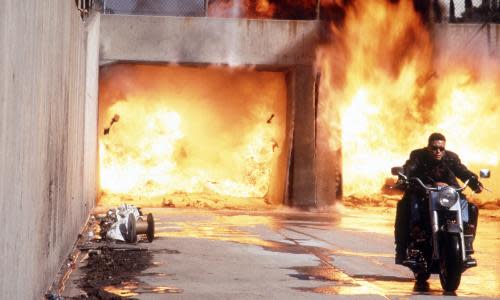Terminator 2 at 30: groundbreaking sequel that led to CGI laziness

How do you kill the man who has everything? In broad strokes, this was the quandary facing James Cameron as he formulated plans for a sequel to The Terminator, the little action picture that rocketed him and star Arnold Schwarzenegger into the ranks of the industry’s most sought-after names.
Related: Robin Hood: Prince of Thieves at 30: a joyless hit that should stay in the 90s
The once and future Governator wowed audiences with his credibility as a cybernetic killing machine, his famously sculpted physique a plausible wrapper for the unstoppable metallic skeleton underneath. (It didn’t hurt that the actor’s shall-we-say limited range also lent itself readily to the role of an entity unencumbered by human behavior.) Even if he was ultimately felled by a hydraulic press, the T-800 evinced the feeling of invincibility, posing a unique challenge for those conceiving his follow-up. It wouldn’t be enough to revive Schwarzenegger’s character and sic him on Linda Hamilton’s mom-of-the-millennium Sarah Connor and her son John one more time. The strongest man in Hollywood, armed literally to the teeth with titanium weaponry, needed a worthy foe.
Cameron and writing partner William Wisher would crack this riddle in time, as $520m’s worth of viewers learned first-hand upon the release 30 years ago today. There was no way they’d find someone more physically imposing than their leading man, so they went in the other direction with character actor Robert Patrick, whose lean and angular frame made him look like the sleeker new model to Ahnuld’s obsolete bulkiness. He gave a humanoid face to the T-1000, a liquid-metal android capable of absorbing and spitting out bullets, melting into floors for camouflage, and reconstituting his exploded cranium. The abilities that would make him a formidable match for the original Terminator solved a conceptual problem and created a slew of practical ones, cueing up the customary beginning phase of Cameron’s process; first, he had to invent the technology he would use to realize his madman vision.
At the time the most expensive movie ever made, Terminator 2: Judgment Day represents the perfect fusion of resources and resourcefulness, Cameron’s pioneering technical might working in concert with his analog film-making skill. In 1991, computer-generated imagery was still a novelty, used to hokey effect in Tron, The Last Starfighter, and even his own The Abyss with the conspicuous check-this-out quality of a futuristic Smell-O-Vision. Beyond collaborating with George Lucas’s elves at Industrial Light and Magic to develop the first-of-its-kind motion-capture process that would make the T-1000 cinema’s first CGI character, Cameron pushed it past gimmickry by tactfully integrating Patrick’s silvery form into the film. $5m was earmarked for a 10-month schedule employing 35 experts, all of it for about five minutes of screen time. Crucially, that’s a cumulative total, with the T-1000’s superpowers – a knife-arm here, a squish through prison bars there – inserted at sporadic intervals instead of in one showstopper sequence detaching viewers from the fiction.
Everything, including and especially the deployment of special effects both digital and jerry-rigged, has been calibrated for maximum popcorn catharsis. The elaborate landscape of miniatures incinerated during Sarah Connor’s prophetic dream of fiery holocaust may not pass for the genuine article when shot in closeup, but by virtue of being corporeal, they’re realer than the CGI-assisted shot of Sarah’s disintegrating skeleton. Same goes for the various robots and copters rumbling through the war of tomorrow, most likely now living second lives as decor in Cameron Manor. It didn’t matter if he had somewhere in the neighborhood of one hundred million bucks to burn. He stretched every last cent as far as it could go, improvising crafty workarounds to bring an organic authenticity to his ghastly melding of flesh with machinery.
There’s a tragic poetry in the timeliness of Terminator 2, having arrived at the fleeting moment right after computerized effects had become feasible, and before they’d grow commonplace. Like the apocryphal story of the escalator inventor who dreamed of accelerating mankind only to watch in horror as lazy people used his creation to stand still, Cameron has seen the equipment he forged to visualize the impossible adopted as a cost-effective way out of doing the work. The recent Terminator sequels have provided a discouraging illustration of that very fall from grace, devoid of the CGI’s revelatory wonder or the handmade effects’ soul.
T2 contains many warnings of apocalyptic events to come, and the most pressing among them concerns the dark fate awaiting the sort of movies produced on this scale, generating this caliber of payday. Aside from the artisanal care taken in its construction, the film has a spiky personality absent from the franchise installments manufactured by assembly line as of late. The pubescent John Connor’s foul mouth, the sudden jags of merciless violence – they come from a time before standards for nine-figure budgets had ossified into palatable routine. The programmer of Skynet, the neural network that would bring about the robo-armageddon the Connors must prevent, stood by as his triumph mutated into his downfall. Cameron, now entombed within the billion-dollar mausoleum that is his perpetually delayed Avatar sequels, could’ve heeded his example.

 Yahoo Movies
Yahoo Movies 